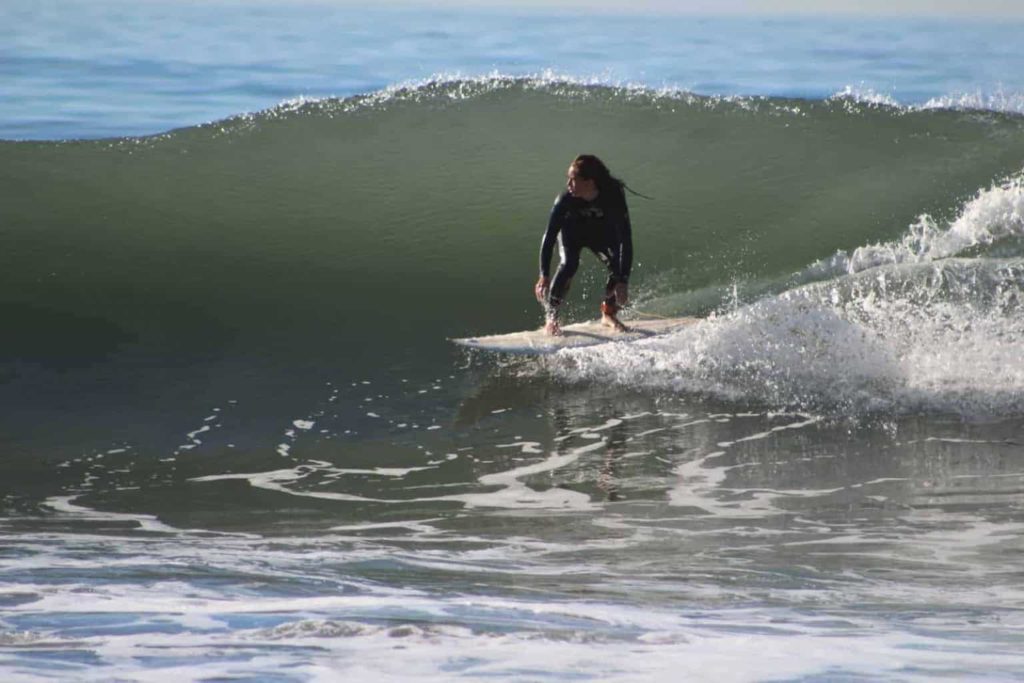Ahhhh… Santa Barbara… The pristine coastline that is FILLED with great surf… right? The coastline in Santa Barbara County has no fewer than 10 right-handed point breaks that will make you bail on work, friends, and other obligations to score some good waves. You might read that and be ready to pack your bags. Don’t! Santa Barbara has by far some of the most inconsistent swells in the state. This is mainly due to the angle of the coastline and the orientation of the Channel Islands located offshore. Winter in Santa Barbara is the most consistent time for surf, but you will have to work to find it. You don’t necessarily need to find waves, just a spot with less than 30 people on it.
There is more consistent swell year-round in Ventura and San Luis Obispo Counties. Santa Barbara is not so lucky. This lack of consistent swell creates an aggressive market for catching waves whenever they come through the channel. Living and surfing here is truly a push and pull between the passion of surfing and the patience that is required to live, and wait, in Santa Barbara for good waves. When they arrive, you have to dedicate all of your free time to fight for your share of waves. If you are just getting into surfing, I definitely recommend taking a lesson first. They can be invaluable to teaching you the ins and outs of what it takes to start surfing.
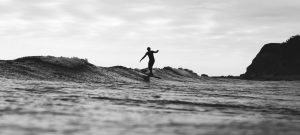
Hometown Spots
Honesty first and foremost, I am a transplant from San Luis Obispo (SLO) County. I came to Santa Barbara for school almost 10 years ago and I never left. Every year I am torn by the swells that consistently slam into SLO county’s beaches while SB remains the Pacific lake. I have come so close to packing my bags and moving back home to be in a spot with more consistent surf. I still go home frequently when I know that my hometown spot is going to be breaking super well. Not going to lie, the warmer water in Santa Barbara is a big reason why I haven’t left. I hated Santa Barbara at first because I couldn’t find any place that would break consistently enough to become my “spot”.
Everyone has a spot in their hometown. This doesn’t mean that you run this spot or have any right to it as a local. I just mean this in the sense that you have a spot that you love surfing over and over again. My spot back home is super fun with fewer people while the “better” spots nearby are too crowded. I personally would rather surf a lesser wave than fight over a slightly better wave. I can fight for waves when I need/want to, but I’d rather casually surf and chat with others in the lineup without jockeying for the best position.
Know When and Where to Surf
Sharing waves is much more enjoyable than fighting over them. That being said, you shouldn’t be bringing a big group of people with you to a spot that isn’t very spread out. If you are going to a place like Mondos Beach, bring as many people as you want! Rincon is a different story; go alone because every extra head in the water is another wave that you will have to fight over. If you are watching a spot, and aren’t seeing any unridden waves, then there is no room for you in the lineup. You could paddle directly into position and take waves from others, but you shouldn’t, because there are plenty of other spots nearby, I promise.
Exploring your local coastline, no matter where you live, is often very useful in finding waves that you might never have surfed before. By finding these new little spots, you are opening up your options of where you feel comfortable surfing. Some of my favorite sessions of all time have been at little hole in the wall spots that I had never tried before. Surfing has always revolved around the new, exciting, and unknown surf spots that are hiding in every nook of the coastline. Finding that new spot with minimal, or zero, people can be a goldmine.
Surf With Purpose
Don’t waste time and energy while in the water. I surfed Rincon today halfway through the workday; I paddled out for 20 minutes and got 3 waves. That is all I needed to have fun. Do not get greedy for more waves in your sessions. You will frustrate yourself and more than likely make a few people in the lineup upset. The moment you feel “stuck” in the lineup without catching any waves is 20 minutes too long that you’ve been in the water. Paddle, catch, and ride your waves with purpose; don’t just paddle out and stumble through your session. Paddle only for waves that you can catch and have priority over in the lineup. Calling someone off a wave and then backing off yourself is a huge no no, and you may get legitimately yelled at for it.
Dropping in on someone is also severely frowned upon in any setting, but doing it during a big Winter swell in Santa Barbara is not ok. The only time you should drop in on someone is if you 100% know they will not make the section. Be prepared to pull right off a wave in case they do make it around to the face.
Consistency
Back to winter in Santa Barbara… It never made sense to me why Morro Bay and Pismo Beach up North would be consistently chest-high minimum year-round while Santa Barbara is flat. I can remember surfing 14 days straight in high school in the middle of summer because swells just kept coming. I began driving to Jalama or FURTHER to find any kind of swell in college because I was so frustrated by the lack of swell in my immediate backyard. Growing up in SLO county has made me so spoiled in terms of having surf year-round.
UCSB’s campus is literally on the ocean. My dorm room was two stone’s throws away from a great right-handed point break. Yet, it rarely broke unless we had a massive WNW swell coming between the Islands and Point Conception. Not having a car during most of my freshman year severely limited my access to surf outside of biking distance. The surf doesn’t always make it through the islands, but the wait is always worth it if you capitalize.
Patience and Persistence
Living in Santa Barbara has taught me a lot about searching for waves and not finding them. Didn’t Edison say that he found 10,000 ways to NOT make a lightbulb? I guess I had a similar experience of finding 10,000 places that don’t work. But I couldn’t tell (at first) if it was just a bad swell angle. It took years to figure out where to check first, and where to check as a last resort. If you want to read a more exhaustive list about where to surf on what swells, check out my other blog, the Santa Barbara Surf Report.
Now that I live in Santa Barbara, I have turned into a commuter surfer. I have to drive an hour north or south during the off-season if I want to have any semblance of a real wave. If I have to drive more than 15 minutes to surf, I feel like I am completely out of my element. When the Winter storms start showing up in Santa Barbara, the hunt is on. When the big storms are pumping, you don’t need to search for waves; most spots are breaking. The trick now is to find a great wave, with fewer people, and a good tide. Numerous waves in the area (including the good ole Queen of the Coast) can change a lot with different tides.

Winter is Coming to Santa Barbara
As I am writing this in November of 2020, I have a lot on my mind. COVID-19 has closed many businesses and parts of the state, but the ocean remains open. This time of year is filled with anticipation of the upcoming surfing season in Santa Barbara. Next week has the first real swell of the season coming in at 12 feet at almost 17 seconds as I’m seeing it now. This year is also different, because of the COVID-19 Pandemic; there has been a larger than usual influx of new surfers this year. People were looking for a new outdoor hobby, and surfing definitely exploded in terms of the number of heads in the water. Before you buy a new board and suit, you should really try at least just renting a board and wetsuit (or take a lesson) before you buy all of the gear.
I almost said that this upcoming surf season isn’t competitive, but that’d be a lie. Winter surfing in Santa Barbara from now through March is absolutely a competition. Who can get to the spot first, wetsuit on first, paddle out first, first wave, etc? You have to truly dedicate yourself to win one of these “contests” if you want to have a decent session without being overcrowded. From late November through most of March is (hopefully) filled with big swells coming from the North West. Winter wave hunting season for us in Santa Barbara is about to start, and there are WAY more people than usual searching for waves.
Know Your Level of Ability
I love surfing and sharing it with other people, however, if you are learning to surf, you should remain surfing at beginner spots. You wouldn’t go down a black diamond your first day on skis, right? So, don’t go to a wave that is too difficult or too crowded. There were far too many beginners at Rincon today. I mean no disrespect to people learning to surf and I encourage it, but please, for the safety of yourself and others, do not surf world-class waves if you do not understand etiquette. If you had no idea there was etiquette in surfing, check out this post that explains the basics.
Board Selection For Winter in Santa Barbara
My dad told me the best way to approach anything was to use the right tools for the right job. Surfing is no exception. I tend to grab a board with more foam/volume than is necessary, all while considering how well it will paddle and duck dive. If I can’t get under a wave then the paddle out can be brutal. If you know the spot well enough to use the currents to your advantage, you will save your arms. I consider myself a strong paddler, but early season Elias will exploit any rip necessary to make the paddle out easier. There are multiple factors regarding board selection that you should take into account during big winter swells. Board length, volume, and fin setup on your step-up are the most important considerations.
A typical step-up board is only going to be a few inches longer than your every-day shortboard, but possibly a little narrower. You want this board to be stable, easier to paddle into waves, and you have to enjoy riding it! Duck diving ability is definitely a factor that will affect how tired you get while paddling out so don’t get a super thick step-up. For fin set up, I typically ride a thruster instead of a quad. I am a big fan of twinny surfboards because I like my boards to feel loose and flowy. I never use more fins than I really need. If I was surfing Pipeline, I would ride quad, but I don’t need 4 fins here in Santa Barbara. Different tail options are more of a personal preference, but pintail and thumb tails are most typical for a step-up.
Long story short, you really should experiment with different boards to find what works best for you.
Trying Different Boards
I grew up lucky enough to have a wall in my garage lined with my dad’s quiver that I was always welcome to use. Trying different boards of all shapes, sizes, and fin setups allowed me to discover what I truly like to ride. I know that not everyone was afforded this luxury, but there are multiple rental options that will allow you to try different kinds of boards. Using a different board than you are used to will improve your balance, wave knowledge, and help you understand how differences in board shape and sizes will affect how the board handles on a wave.
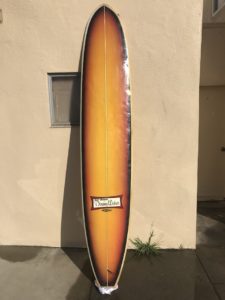
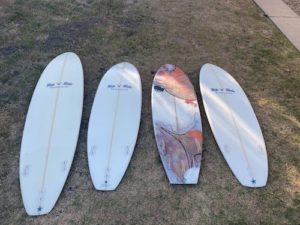
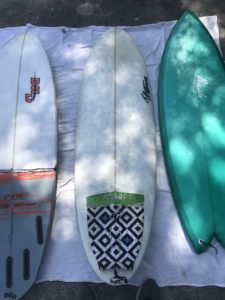
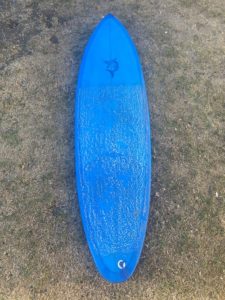
Plan of Attack
For example, I had work this morning at 9 am. I woke up at 7 and went to three different spots to see what was breaking best. I was not actually trying to surf this morning, just scouting. The swell wasn’t quite here yet but some sneaky set waves were starting to pulse, and I needed to find where I would surf later in the day. Thankfully, my boss had already told me I could take off in the middle of the day to surf. He was doing the same thing and he is super generous when swell arrives. I got a call from a coworker that was off for the day that spot B was pumping. I clocked out and went surfing until after dark! I’m not going to tell you where I was because I don’t want any more people there…
Sacrifices
This is the time of year that I really do have to sacrifice certain things and prioritize surfing. If I miss a swell in the Winter, I lose a big percentage of my wave count for the entire season. I hate that I said “have to sacrifice” because surfing can get in the way of other parts of life in the winter months. The days are shorter and therefore sunlight is much more precious. Surfing after work is not an option when the sun sets before 5. The crack of dawn (or earlier) is the only option I have to surf.
When we start to get more sunlight later in the Winter I will be on my own schedule that revolves around the surf I can get. I don’t make dinner plans, I don’t watch the sunset with friends, and I don’t make any other kinds of plans that could interfere with surfing. It’s a bummer to make these sacrifices, but I make it worth it by finding good waves (hopefully). This is simply the surfing lifestyle that comes with living in Santa Barbara. Being methodical in how you go surfing is the difference between a good and a bad session.
Why does Santa Barbara have a shortage of waves during the summer?
California essentially has two different seasons for swell windows; Summer and Winter. Summer swells typically come from the Southern Hemisphere, while Winter swells typically come from the Northern Hemisphere. When you look at the orientation of Santa Barbara’s coastline, you would think that the South Swells are the best angle. South swells come directly towards our South facing shoreline, but there is a little problem. Well, actually a pretty sizable problem; Channel Islands National Park. Located roughly 15-30 miles offshore, these islands form a natural barrier that protects our coastline from the swell. I love the islands and all of their beauty, but I wish they were somewhere else!
Wave Tracking
The islands are perfectly spaced out that Santa Barbara is almost entirely blocked from South Swells. That being said, the bathymetry around the islands will occasionally allow the swell to wrap towards Santa Barbara’s Coastline. Bathymetry is essentially the underwater equivalent of topography on land. Sand vs rock vs reef bottom can have a tremendous impact on how a wave breaks, as well as how it tracks through the open ocean. The friction of the wave feeling the ocean floor will slow down the swell in shallower water. The same swell will move more quickly in deeper water. South swells will sneak around the islands occasionally and make a couple of spots break, but you have to get lucky; timing, tide, and angle of the swell play a huge role in determining if something will break.
If you are interested in learning more about bathymetry, check out this article that goes into more detail. Check out this other piece on tides and how they affect surf as well! There are so many factors that interact with each other to create good conditions for surfing, and learning more about them will help you become a better surfer, and surf forecaster. Too many people have come to rely on surf reports like Surfline; learn to read the buoys to understand which spots may be breaking on which angles and swell periods.
Other Surf Options in the Summer
Thankfully, if you drive towards Ventura, the south swells will show at places like Ventura Harbor or Ventura Point. All while Santa Barbara lays dormant, waiting for the big Northwest swells to pick up in the Fall and Winter. If you don’t want to go further South and battle the crowds in the Summer, then heading North would be a good option to find decent surf with fewer crowds, but the trade-off being the water can be significantly cooler.
If you have any young ones that are interested in getting into surfing, check out our Surf Camp that we offer during the Summer months. While the waves will be smaller in the Summer, kids will need to start on smaller waves. They need to build confidence and knowledge of the ocean and how waves break before getting into the water on bigger Winter swells in Santa Barbara. Typically, the age range at our surf camps are 6-12, but this is somewhat flexible; feel free to reach out if you have any questions!
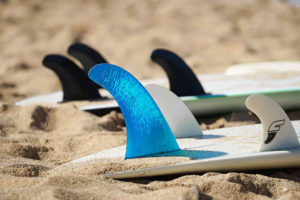
Winter Activities in Santa Barbara When The Waves are Flat
I personally love the beaches of Santa Barbara in the Winter, even when there are no waves. There are fewer tourists, and the sun is usually still shining! When the surf is down, I can relax and just enjoy the beach without thinking about where to surf. Sometimes I’ll take a paddle board out from West Beach, or maybe a kayak if I really want to make it a leisurely paddle through the harbor and around to Leadbetter. Most point breaks have stronger currents with big swells because of how the swells move along the shore. I always make sure to get into paddling shape BEFORE Winter arrives. Paddle boarding and Kayaking are great ways to stay in shape during COVID when there is a lack of swell. If you are in Santa Barbara on a surf trip, make sure to check out the food and beverage scene too!
The collection of restaurants, breweries, and wineries in Santa Barbara will allow you to go somewhere new every day. I have numerous favorite restaurants, but my favorite general area for food is in the Funk Zone. You can find traditional Spanish Tapas at Loquita SB, the best burrito (and salsa bar) in town at Mony’s Taqueria, all while exploring and trying new beers and wines from local tasting rooms nearby. Some companies even offer fun approaches to wine and beer tasting in the Funk Zone, such as the Bike and Beverage Tour with Cal Coast Adventures. The Funk Zone is such a fun area of Santa Barbara and you will find something for everyone; from coffee to murals on entire buildings. Cozy up next to the fire at Dart Coffee gardens after a cold morning session!

